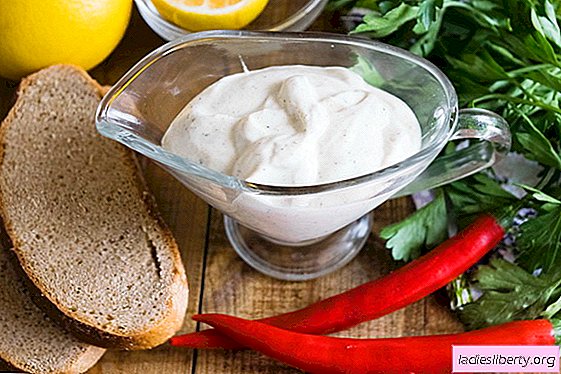
Two housewives can knead the dough according to one recipe, but get completely different results. There are small and even insignificant at first glance errors that radically change the outcome. Let's disassemble them?
Mistake One: Yeast
We take yeast that is not expired, be sure to check the expiration date. They are added in small quantities, occupying almost a hundredth of the rest of the products. Therefore, you can not lay them “by eye” or independently determine the portion. Everything is indicated in the recipe. If in doubt, it is better to look at the packaging with yeast, there should be recommendations from the manufacturer.
Common mistakes:
- Little yeast. As a result, the dough rises for a very long time and slowly, resulting in heavy baking.
- A lot of yeast. The dough rises too fast and sour. Baking from it has an unpleasant taste, smell, it does not fry, it turns out solid cakes and rolls.
- Poor dissolution. Pressed yeast is diluted in a liquid. Dry yeast can also be dissolved or combined with flour. You just can’t throw it to all other products, they will grab into tight lumps.
To always make the dough, it is advisable to have a kitchen scale at home. They are needed not only for yeast, but also for other ingredients.
Second mistake: water temperature
Hot liquid will destroy the yeast, as a result, the dough simply will not rise, and the baking will be stiff, heavy, not baked inside. If the water or milk is cold, then the yeast will not work, it will take too much time to rise. Before use, fluids need to be heated to 40-45 degrees. When the remaining ingredients are added, the temperature will drop slightly. Melted fats cool, they can not be added hot.
By the way, it is recommended to warm up not only liquids, but also to remove eggs from the refrigerator in advance, leave sugar and flour on the table. All products must have room temperature.
Mistake Three: Sequence
This is a common mistake of young housewives or owners of planetary mixers. Cool in advertising: I threw the products into the bowl, everything was mixed up, it turned out the dough. In real life, this will not work. You can lay everything in a bunch only in a bread machine. With manual kneading, you will have to follow the correct sequence.
How to knead the dough:
- Preheat fluid. Usually it is milk or water, sometimes whey or a mixture of different ingredients.
- Add yeast and a little sugar, literally a spoon. Pour a little flour, make a talker. The consistency of pancake dough. Let stand for a quarter of an hour. Yeast will start to work, it will be clear from the foam.
- Shake the eggs with the rest of the sugar, add salt to them.
- Pour the eggs into the talker. Stir, after which we introduce the melted, but not hot oil.
- Sift flour and add last, knead the dough. Stretch your hands, you can pour a little more vegetable oil, literally one spoon.
If vanilla, cinnamon, some dried fruits, nuts are found in the dough. Then they are first mixed with flour, only after that everything is sent together to the total mass.
Fourth error: the amount of flour
The consistency of the dough affects the quality of baking. The amount of flour may vary each time. Of course, you should focus on the recommended recipe weight, but not always. If the flour is wet, it will take more. Also, the eggs have different sizes, different fat content of dairy products.
Lush and airy pastries are obtained only from soft yeast dough. It is important not to hammer it with flour.
If the dough is too steep, then the rise time will be delayed, it will be difficult for yeast to work. Baking from such a mass crumbles, quickly becomes stale. If the dough is for bread or a large cake, then it can stick a little to your hands, slightly creep on the table, there is nothing wrong with that.
If you plan to make buns or pies in the oven, then add a little more flour so that the products keep their shape, do not spread on the baking sheet.
Fifth error: the dough did not stand long
It is not enough for yeast to simply raise the dough; the mass must gain a certain acidity. If this does not happen, the pastries will quickly harden, it will not taste good. It is believed that the yeast test needs to rise twice. After the first rise it is lowered by hands, after the second time they begin to form pies or other products.
The rise time depends on various factors: the rate of yeast and their quality, room temperature, amount of dough, presence or absence of dough.
But the first time the dough always rises longer. On average, it will take from 1.5 to 2 hours. The second climb can take only half an hour. Sometimes the test is allowed to rise once in the total mass, and then left to lie on the table. In this case, you need to cover the pieces with a napkin so that the crust does not dry out.
Sixth error: the dough stopped
If the dough does not stand, then this is bad. But even worse when it is peroxide. You can determine the pungent odor. If the room is hot, then the mass can deteriorate in 5-6 hours. Baking from peroxidized dough is tasteless, since there is practically no sugar in it. Crust does not form on the products; they do not fry; they do not rise well in the oven.
Advice! If there is no time for baking, you can put the dough immediately after the batch into the refrigerator, there it will rise more slowly.
Seventh error: a lot of muffin
It happens that buns or pies are very tasty, ruddy, smell pleasant, but heavy in weight and small in size. The reason is a lot of muffin. Oil and sugar are recommended to be laid down strictly according to the norm. It is difficult to work with heavy and saturated dough, it is advisable to increase their number. For this reason, the dough for Easter cakes sometimes costs 8-10 hours, which is not good.
Advice! If you want to get tasty and sweet buns, then it is better to use additives for decoration or filling.
Eighth mistake: no rise before baking
Products from a fluffy and well-risen dough always need to stand on a baking sheet or in shape, to rise for the last time. This can take up to 40-60 minutes. The easter cakes are the longest. If you immediately send the rolls into the oven immediately after the formation, they will start to rise sharply, tears will appear on the sides, the products will squint, and you will get a dense and non-porous crumb.
The main secret of working with yeast dough is not a cool recipe, but a good mood and warm hands. Only in this case, the pastries will please the taste.











